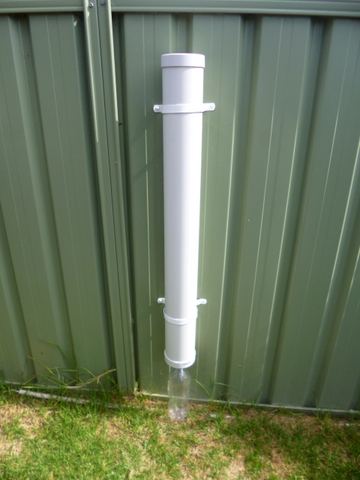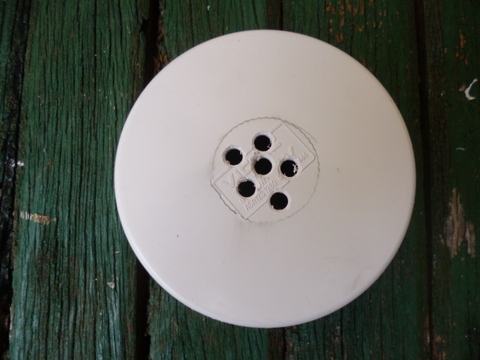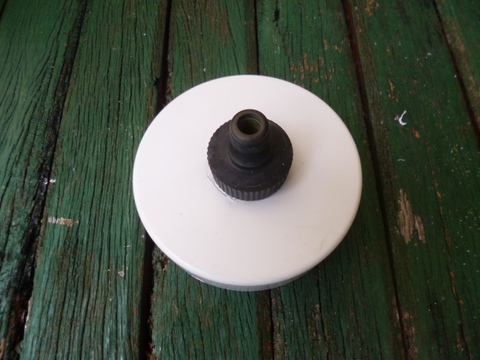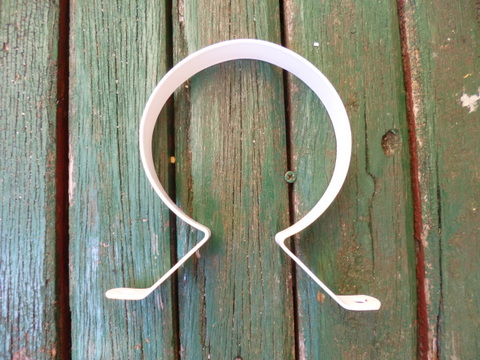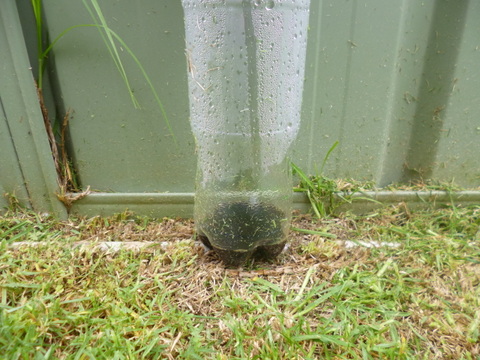Comfrey is a very easy to grow and useful herb. Among other things it is a dynamic accumulator; that is to say it sends its long taproot down into the soil, brings up nutrients inaccessible to other shallower rooting plants and accumulates them in its leaves. There are a number of ways to make these nutrients available to other plants, the simplest being to cut the leaves regularly and leave them as a mulch under the plants you wish to fertilise. The leaves break down over time and the other plants get the benefits of the extra nutrients, but there is another way where you can concentrate or extract the nutrients in liquid form. This is how to build a gadget to do it.
The idea is to confine the comfrey leaves within a container and allow them to break down, applying a weight to provide pressure and extract the liquid nutrients from the leaves as they break down, then channel them into a container for use. To make the extractor I used some storm water pipe, some pipe fittings and a couple of 1.25 litre recycled soft drink containers.
The Pipe
While the diameter and/or length of the pipe isn’t critical, the larger the pipe you have the more comfrey leaves you can fit in at any one time. I used a 1 metre length of 110mm outside diameter pipe. I use this because it was available, a good size to work with and fitted the soft drink bottle fairly snugly while still allowing it free movement.
I had to buy in a couple of push-on end caps and a couple of purpose designed brackets to allow me to mount the pipe on the fence, but that didn’t amount to much and I found the rest floating around the house.
The extractor will be mounted vertically so there will be some weight on what will become the bottom end cap so I intended to glue that one on. Also, there should be no need to remove it.
The bottom end cap was also where the comfrey extract will be flowing out of, so I needed to install a delivery pipe before fixing it to the bottom of the pipe. I got hold of a garden hose tap fitting I had hanging around and placed on the centre of the bottom end cap. Using the tap fitting as a template I drew a circle around the edge with a pencil and then drilled half a dozen 6mm (1/4 inch) holes inside the pencil circle. I then fixed the tap fitting to the end cap over the drilled holes using silicone sealer. After giving the silicone 24 hours to cure, I glued the end cap onto the pipe using plumbers glue.
The top end cap was not going to be glued on because it did need to be removable to add comfrey leaves, install and retrieve the weight and to clean the pipe out when required. It is mainly there to keep rain out of the pipe to prevent it prematurely diluting the extract. I did drill a 6mm hole in the centre of the cap (location of the hole is not critical) so that I could run the string through the hole which is attached to the weight.
The Weight
From my original readings I thought that the weight was going to somehow force the juice out of the leaves as they were but subsequent research has shown that the leaves have to decompose before the nutrients are extracted. I decided that the maximum weight would work the best. The 1.25litre soft drink bottle if filled to capacity with water would weight about 1.25 kilograms, or in other words basically the weight of the water. To increase the weight I first filled the bottle with coarse sand, then slowly ran the water in so that it infiltrated between the sand particles until the bottle was full. The bottle now weighed 2.6 kilograms, which sounded to me like a good weight to do the trick.
All that was needed now was to tie some strong twine around the neck of the bottle, which I could use to lower the bottle into the pipe and then retrieve it as required. The free end of the twine was then run through the hole in the top cap, and the tied to a wire ‘key-ring’ style ring to prevent it slipping into the tube.
Installing the Tube
After casting around where to set up the tube I decided to place it on the north face of our southern fence, I figured a bit of warmth from the sun will help with the decomposition. I suspect that the location is not critical except to make sure that you can easily get to it and you can remove it when required. Being able to remove it from its mounting and turn it upside down to remove spent leaves will make the eventual cleaning much easier.
Our fences are colourbond steel so I lined up the brackets so that they were straddling a channel and the fixing holes were sitting on flat steel. The brackets need to hold the tube in a vertical orientation so they have to apply some pressure to the tube to prevent it slipping downward. I set it up so that the second plastic soft drink bottle fitted neatly under the tap fitting on the bottom cap with a minimum clearance. I then drilled a pilot hole and screwed in two screws to the top bracket and two for the bottom.
To complete the job I placed some clapped out stainless steel mesh pot cleaner in the bottom of the tube to prevent the leaves from blocking the drain holes. It was then just a case of harvesting and packing the comfrey leaves into the tube and then installing the weight and the top push-on cap. I half-filled the tube with as many leaves as I could get with one harvest. It took about a week for some extract to drip down into the lower collection bottle. It is late summer here and I suspect you should allow more time in case you are doing this at a cooler time of year or in a cooler climate.
To use the extract, dilute it about 20:1 with water, apply around the base of the plants which you wish to fertilise and water in.



